 Coffee prices have been soaring in recent months. This applies to the prices of both coffee beans on international markets, coffee in supermarkets and coffee in coffee shops. In this blog we examine the causes and what is likely to happen over the coming months.
Coffee prices have been soaring in recent months. This applies to the prices of both coffee beans on international markets, coffee in supermarkets and coffee in coffee shops. In this blog we examine the causes and what is likely to happen over the coming months.
As we shall see, demand and supply analysis provides a powerful explanation of what has been happening in the various sectors of the industry and the likely future path of prices.
The coffee industry
The cultivating, processing and retailing of coffee is big business. It is the second most widely traded commodity after oil and around 2.5 billion cups are consumed worldwide on a daily basis. In the UK nearly 100 million cups of coffee a day are drunk, with coffee consumers spending around £4 billion per year on sit-down and takeaway coffees and on coffee bought in supermarkets and other shops for making at home. The average takeaway coffee costs around £3.40 per cup with speciality coffees costing more.
Global production in the coffee year 2023/24 was 178 million 60 kg bags (10.7 million tonnes) and the annual income of the whole sector exceeds $200 billion. Around 25 million farmers spread across 50 countries harvest coffee. The majority of these farms are small and family run. Some 100 million families worldwide depend on coffee for their living.
Brazil is by far the biggest producer and accounts for nearly 40% of the market. A good or poor harvest in Brazil can have a significant impact on prices. Vietnam and Columbia are the second and third biggest producers respectively and, with Brazil, account for over 60% of global production.
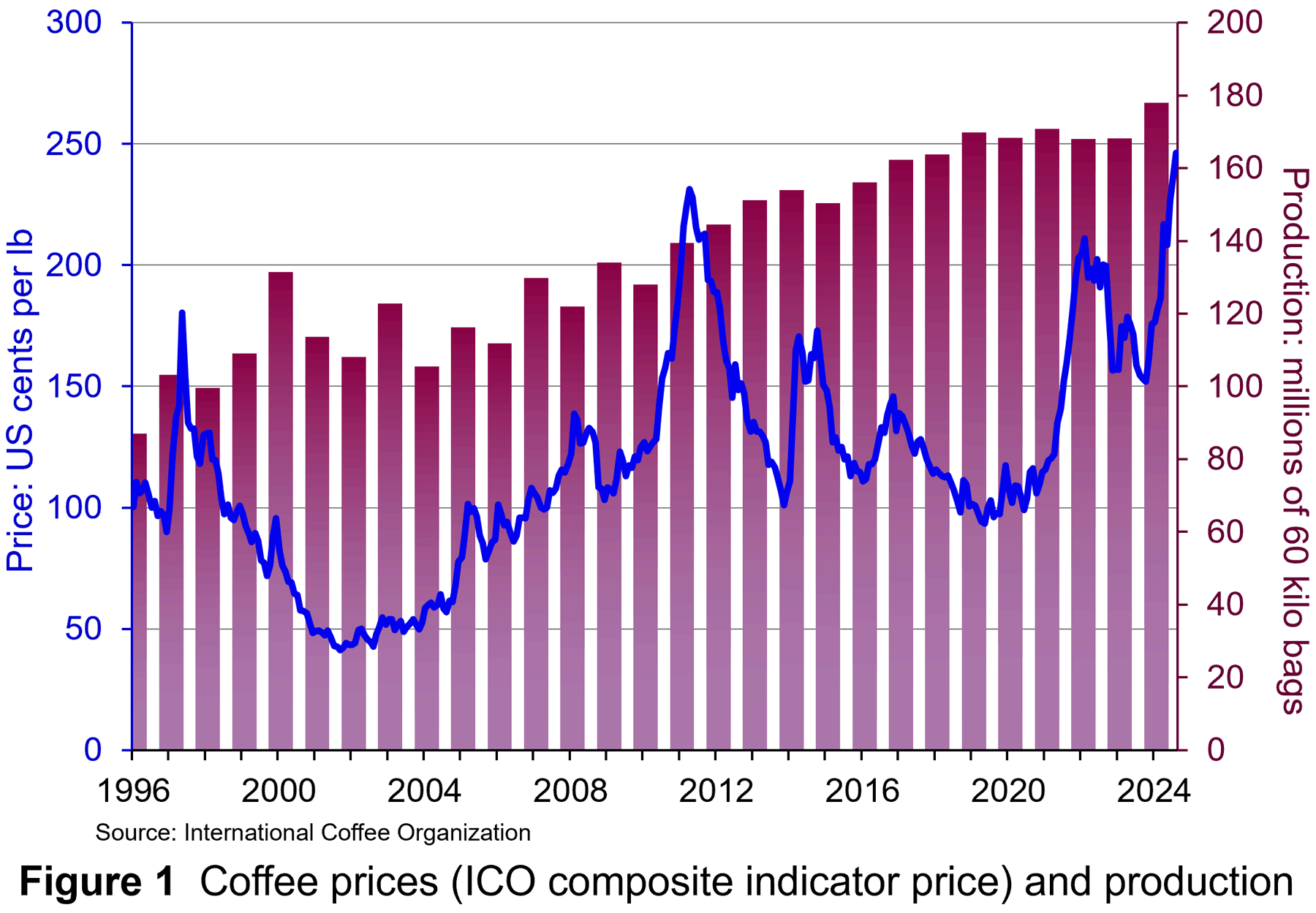 Coffee prices are extremely volatile – more so than production, which does, nevertheless, fluctuate with the harvest. Figure 1 shows global coffee production and prices since 1996. The price is the International Coffee Organization’s composite indicator price (I-CIP) in US cents per pound (lb). It is a weighted average of four prices: Colombian milds (Arabica), Other milds (Arabica), Brazilian naturals (mainly Arabica) and Robusta. Production is measured in 60 kilo bags.
Coffee prices are extremely volatile – more so than production, which does, nevertheless, fluctuate with the harvest. Figure 1 shows global coffee production and prices since 1996. The price is the International Coffee Organization’s composite indicator price (I-CIP) in US cents per pound (lb). It is a weighted average of four prices: Colombian milds (Arabica), Other milds (Arabica), Brazilian naturals (mainly Arabica) and Robusta. Production is measured in 60 kilo bags.
Case Study 2.3 on the student website for Economics 11th edition, looks at the various events that caused the fluctuations in prices and supply illustrated in Figure 1 (click here for a PowerPoint). In this blog we focus on recent events.
Why are coffee prices rising?
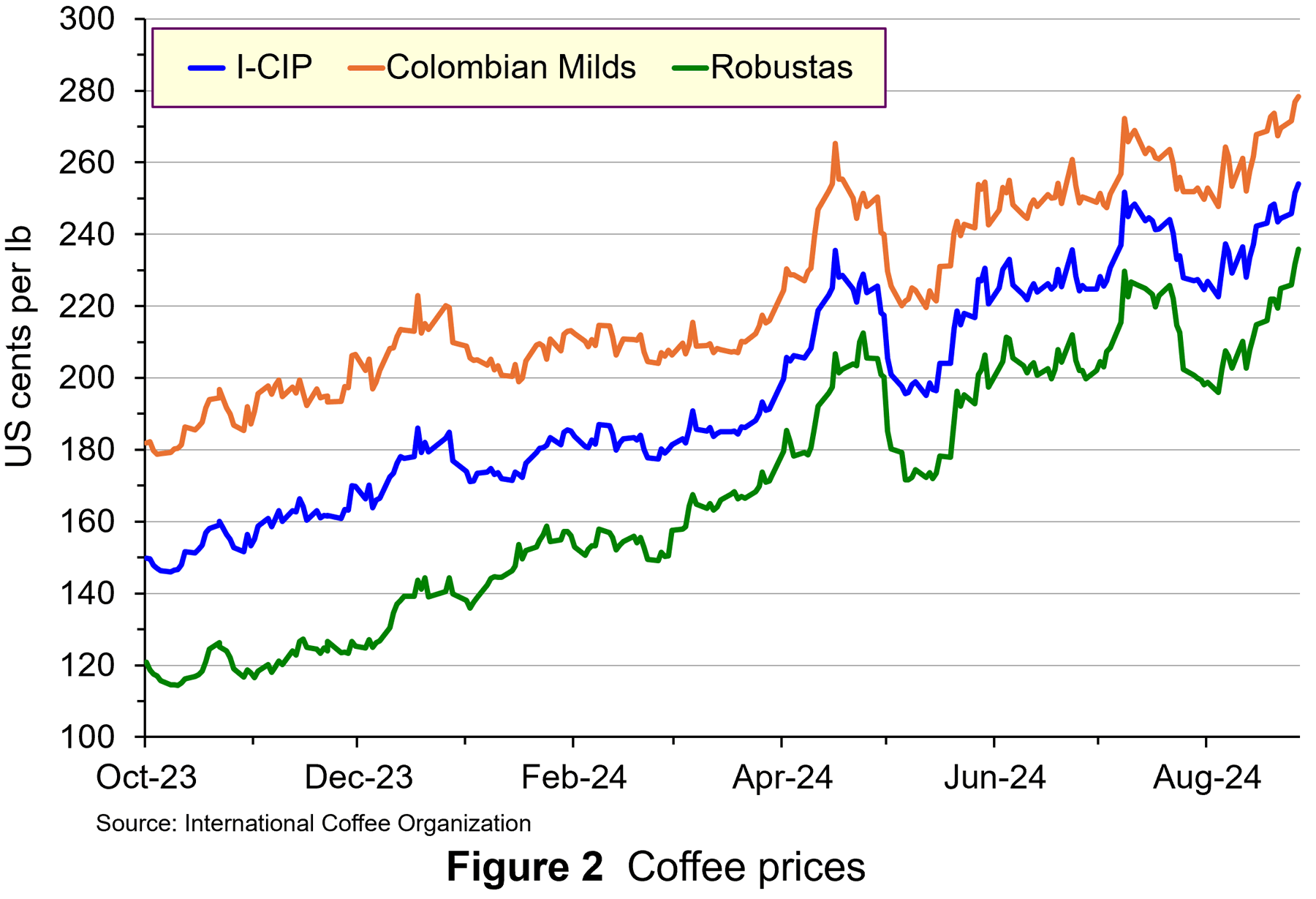 In early October 2023, the ICO composite indicator price (I-CIP), was $1.46 per lb. By 28 August, it had reached $2.54 – a rise of 74%. Colombian milds (high-quality Arabica) had risen from $1.79 per lb to $2.78 – a rise of 55%. Robusta coffee is normally cheaper than Arabica. It is mainly used in instant coffee and for espressos. As the price of Arabica rose, so there was some substitution, with Robusta coffees being added to blends. But as this process took place, so the gap between the Arabica and Robusta prices narrowed. Robusta prices rose from $1.14 in early October 2023 to £2.36 in late August – a rise of 107%. These prices are illustrated in Figure 2 (click here for a PowerPoint).
In early October 2023, the ICO composite indicator price (I-CIP), was $1.46 per lb. By 28 August, it had reached $2.54 – a rise of 74%. Colombian milds (high-quality Arabica) had risen from $1.79 per lb to $2.78 – a rise of 55%. Robusta coffee is normally cheaper than Arabica. It is mainly used in instant coffee and for espressos. As the price of Arabica rose, so there was some substitution, with Robusta coffees being added to blends. But as this process took place, so the gap between the Arabica and Robusta prices narrowed. Robusta prices rose from $1.14 in early October 2023 to £2.36 in late August – a rise of 107%. These prices are illustrated in Figure 2 (click here for a PowerPoint).
This dramatic rise in prices is the result of a number of factors.
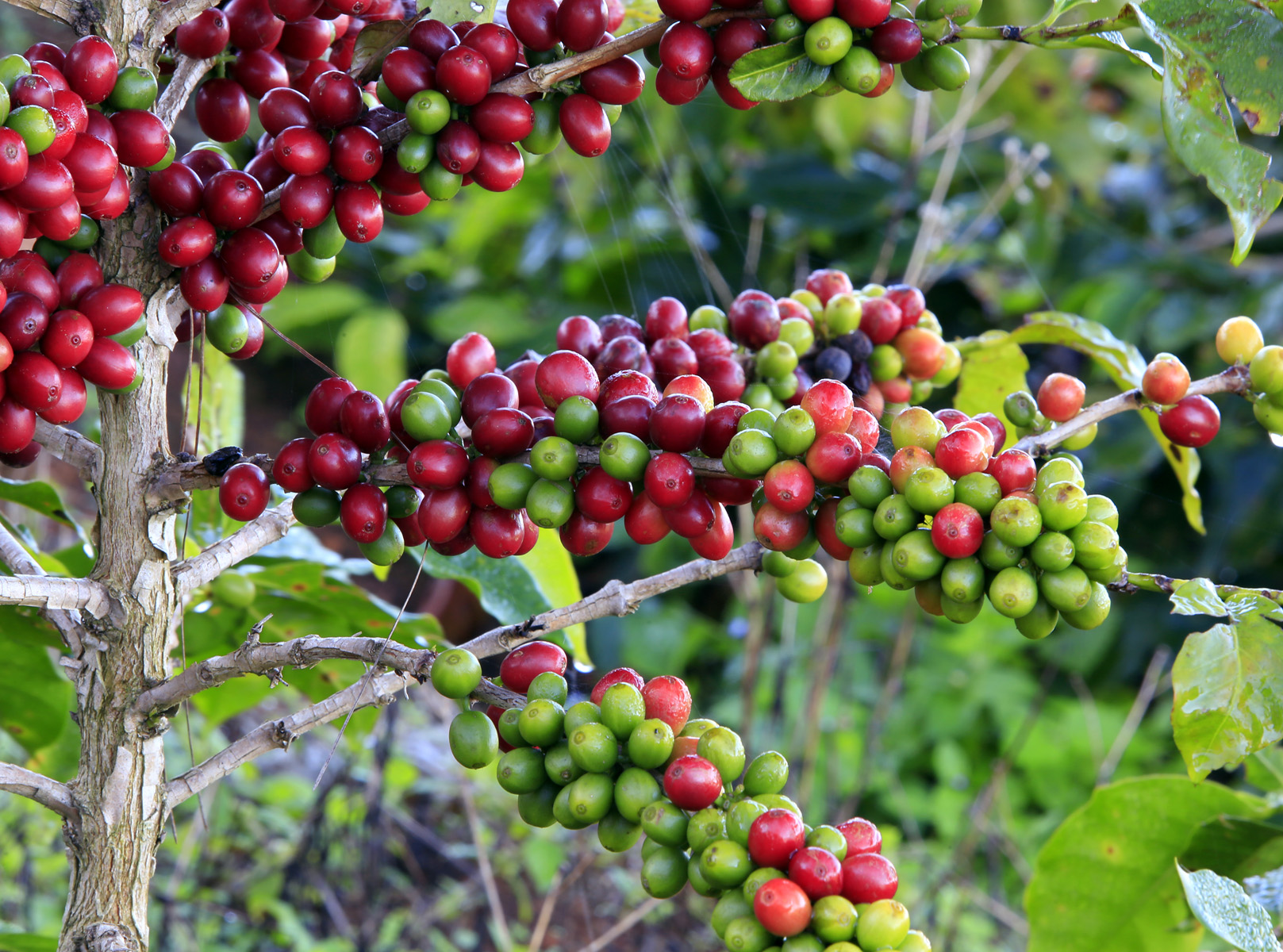 Supply-side factors. The first is poor harvests, which will affect future supply. Frosts in Brazil have affected Arabica production. Also, droughts – partly the result of climate change – have affected harvests in major Robusta-producing countries, such as Vietnam and Indonesia. With the extra demand from the substitution for Arabica, this has pushed up Robusta prices as shown in Figure 2. Another supply-side issue concerns the increasingly vulnerability of coffee crops to diseases, such as coffee rust, and pests. Both reduce yields and quality.
Supply-side factors. The first is poor harvests, which will affect future supply. Frosts in Brazil have affected Arabica production. Also, droughts – partly the result of climate change – have affected harvests in major Robusta-producing countries, such as Vietnam and Indonesia. With the extra demand from the substitution for Arabica, this has pushed up Robusta prices as shown in Figure 2. Another supply-side issue concerns the increasingly vulnerability of coffee crops to diseases, such as coffee rust, and pests. Both reduce yields and quality.
As prices have risen, so this has led to speculative buying of coffee futures by hedge funds and coffee companies. This has driven up futures prices, which will then have a knock-on effect on spot (current) prices as roasters attempt to build coffee stocks to beat the higher prices.
There have also been supply-chain problems. Attacks on shipping by Houthi rebels in the Red Sea have forced ships to take the longer route around the Cape of Good Hope. Again, this has particularly affected the supply of Robusta, largely grown in Asia and East Africa.
New EU regulation banning the import of coffee grown in areas of cleared rainforest will further reduce supply when it comes into force in 2025, or at least divert it away from the EU – a major coffee-consuming region.
 Demand-side factors. On the demand side, the rise of the coffee culture and a switch in demand from tea to coffee has led to a steady growth in demand. Growth in the coffee culture has been particularly high in Asian markets as rapid urbanistion, a growing middle class and changing lifestyles drive greater coffee consumption and greater use of coffee shops. This has more than offset a slight decline in coffee shop sales in the USA. In the UK, the number of coffee shops has risen steadily. In 2023, there were 3000 cafés, coffee chains and other venues serving coffee, of which 9885 were branded coffee shop outlets, such as Costa, Caffè Nero and Starbucks. Sales in such coffee chains rose by 11.9% in 2023. Similar patterns can be observed in other countries, all helping to drive a rise in demand.
Demand-side factors. On the demand side, the rise of the coffee culture and a switch in demand from tea to coffee has led to a steady growth in demand. Growth in the coffee culture has been particularly high in Asian markets as rapid urbanistion, a growing middle class and changing lifestyles drive greater coffee consumption and greater use of coffee shops. This has more than offset a slight decline in coffee shop sales in the USA. In the UK, the number of coffee shops has risen steadily. In 2023, there were 3000 cafés, coffee chains and other venues serving coffee, of which 9885 were branded coffee shop outlets, such as Costa, Caffè Nero and Starbucks. Sales in such coffee chains rose by 11.9% in 2023. Similar patterns can be observed in other countries, all helping to drive a rise in demand.
But although demand for coffee in coffee shops is growing, the rise in the price of coffee beans should have only a modest effect on the price of a cup of coffee. The cost of coffee beans purchased by a coffee shop accounts for only around 10% of the price of a cup. To take account of the costs to the supplier (roasting, distribution costs, overheads, etc), this price paid by the coffee shop/chain is some 5 times the cost of unroasted coffee beans on international markets. In other words, the international price of coffee beans accounts for only around 2% of the cost of a cup of coffee in a coffee shop.
Higher coffee-shop prices are thus mainly the result of other factors. These include roasting and other supplier costs, rising wages, rents, business rates, other ingredients such as milk and sugar, coffee machines, takeaway cups, heating, lighting, repairs and maintenance and profit. The high inflation over the past two years, with several of these costs being particularly affected, has been the major driver of price increases in coffee shops.
The future
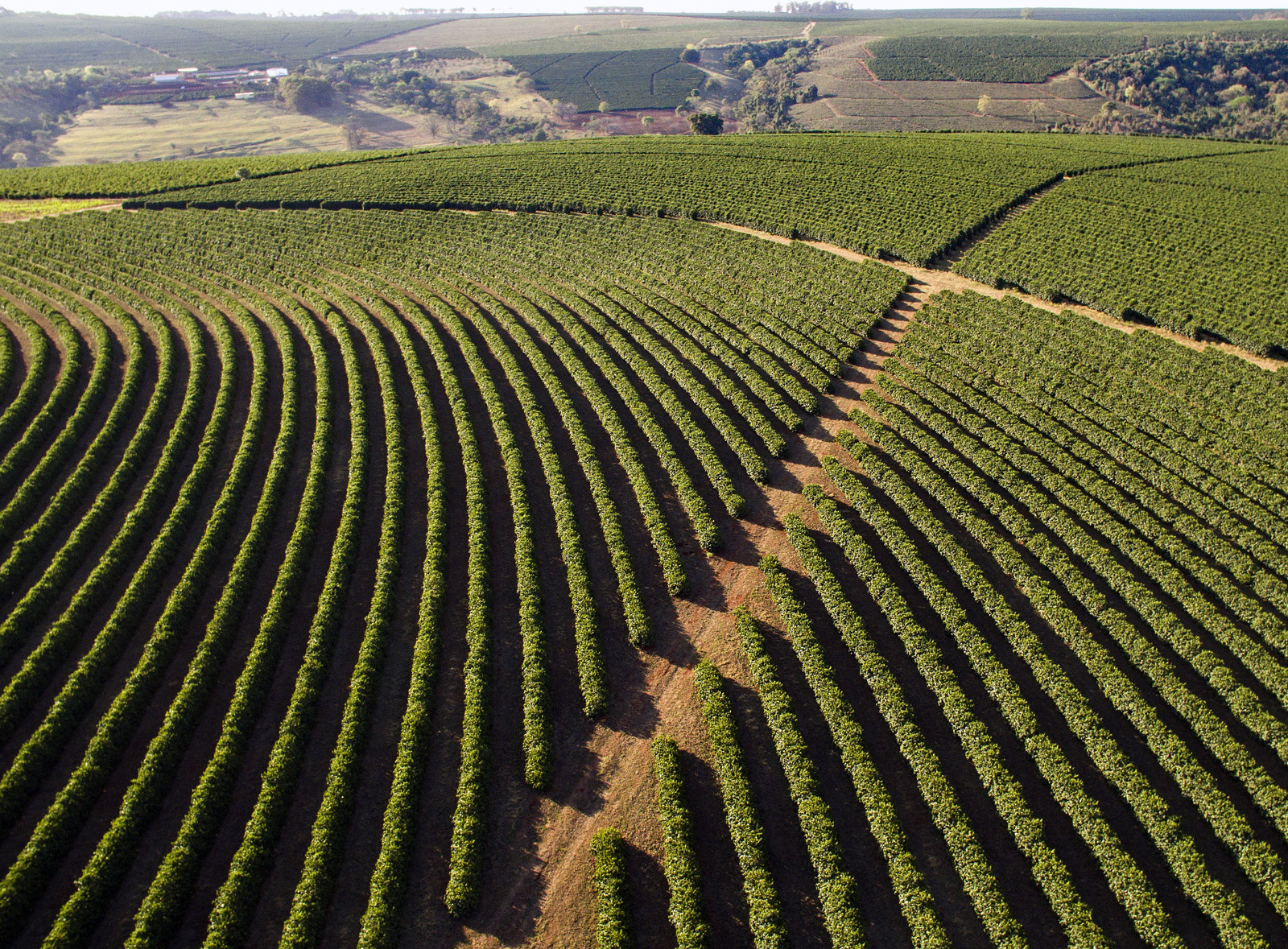 The rise in demand and prices over the years has led to an increase in supply as more coffee bushes are planted. As Figure 1 shows, world supply increased from 87 million in 1995/6 to 178 million 60 kilo bags in 2023/4 – a rise of 105%. The current high prices may stimulate farmers to plant more. But as it can take four years for coffee plants to reach maturity, it may take time for supply to respond. Later on, a glut might even develop! This would be a case of the famous cobweb model (see Case Study 3.13 on the Essentials of Economics 9th edition student website).
The rise in demand and prices over the years has led to an increase in supply as more coffee bushes are planted. As Figure 1 shows, world supply increased from 87 million in 1995/6 to 178 million 60 kilo bags in 2023/4 – a rise of 105%. The current high prices may stimulate farmers to plant more. But as it can take four years for coffee plants to reach maturity, it may take time for supply to respond. Later on, a glut might even develop! This would be a case of the famous cobweb model (see Case Study 3.13 on the Essentials of Economics 9th edition student website).
Nevertheless, climate change is making coffee production more vulnerable and demand is likely to continue to outstrip supply. Much of the land currently used to produce Arabica will no longer be suitable in a couple of decades. New strains of bean may be developed that are more hardy, such as variants of the more robust Robusta beans. Whether this will allow supply to keep up with demand remains to be seen.
Articles
- Even more expensive coffee prices are brewing, but there are some good reasons why
The Conversation, Jonathan Morris (31/7/24)
- Coffee is becoming a luxury, and there’s no escaping it
AccuWeather, Erika Tulfo (1/8/24)
- Coffee prices will rise even higher, says Giuseppe Lavazza
The Guardian, Jonathan Yeboah (9/7/24)
- Coffee prices set to rise even higher, warns Italian roaster Lavazza
Financial Times, Susannah Savage (9/7/24)
- Soaring coffee prices force roasters to add lower-cost beans to blends
Financial Times, Susannah Savage (24/8/24)
- Soaring coffee prices foretell a financial grind
Reuters, Robert Cyran (31/8/24)
- Projected Coffee Price Increase Due to Supply Shortages and Rising Demand
ISN Magazine: International Supermarket News (14/8/24)
- Coffee Market Report
International Coffee Organization (July 2024)
- Strengthening global robusta production: an update
World Coffee Research: News (4/12/23)
- Houthi rebels and the EU make your coffee more expensive
Politico, Carlo Martuscelli (13/8/24)
Data
Questions
- Use a demand and supply diagram to compare the coffee market in August 2024 with that in October 2023.
- How is the price elasticity of demand relevant to determining the size of price fluctuations in response to fluctuations in the supply of coffee? Demonstrate this with a supply and demand diagram.
- How has speculation affected coffee prices?
- What are ‘coffee futures’? How do futures prices relate to spot prices?
- What is likely to happen to coffee prices in the coming months? Explain.
- Why have Robusta prices risen by a larger percentage than Arabica prices? Is this trend likely to continue?
- Look at the price of Colombian Arabica coffee in your local supermarket. Work out what the price would be per lb and convert it to US dollars. How does this retail price compare with the current international price for Colombian milds and what accounts for the difference? (For current information on Colombian milds, see the third data link above.)
- Distinguish between the fixed and variable costs of an independent coffee shop. How should the coffee shop set its prices in relation to these costs and to demand?
What do tulips, nickel mining in Australia, South Seas trading, Beanie Babies and cryptocurrencies have in common? The answer is that they have all been the subject of speculative bubbles. In the first four cases the bubble burst. A question currently being asked is whether it will happen to bitcoin.
Bitcoin
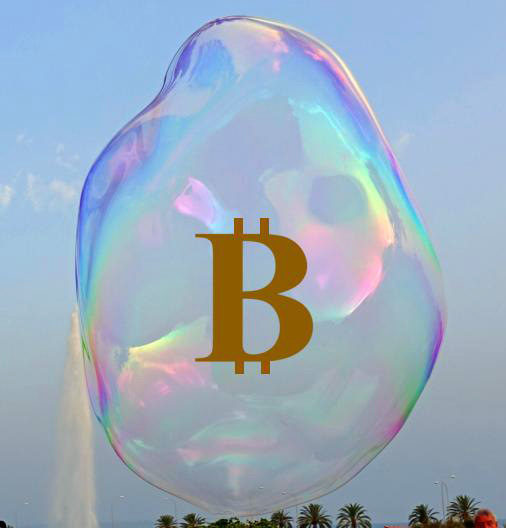 Bitcoin was created in 2009 by an unknown person, or people, using the alias Satoshi Nakamoto. It is a digital currency in the form of a line of computer code. Bitcoins are like ‘electronic cash’ which can be held or used for transactions, with holdings and transactions heavily encrypted for security – hence it is a form of ‘crytocurrency’. People can buy and sell bitcoins for normal currencies as well as using them for transactions. People’s holdings are held in electronic ‘wallets’ and can be accessed on their computers or phones via the Internet. Transfers of bitcoins from one person or organisation to another are recorded in a public electronic ledger in the form of a ‘blockchain‘.
Bitcoin was created in 2009 by an unknown person, or people, using the alias Satoshi Nakamoto. It is a digital currency in the form of a line of computer code. Bitcoins are like ‘electronic cash’ which can be held or used for transactions, with holdings and transactions heavily encrypted for security – hence it is a form of ‘crytocurrency’. People can buy and sell bitcoins for normal currencies as well as using them for transactions. People’s holdings are held in electronic ‘wallets’ and can be accessed on their computers or phones via the Internet. Transfers of bitcoins from one person or organisation to another are recorded in a public electronic ledger in the form of a ‘blockchain‘.
The supply of bitcoins is not controlled by central banks; rather, it is determined by a process known as ‘mining’. This involves individuals or groups solving complex and time-consuming  mathematical problems and being rewarded with a new block of bitcoins.
mathematical problems and being rewarded with a new block of bitcoins.
The supply of bitcoins is currently growing at around 150 per hour and the current supply is around ₿16.7 million. However, the number of new bitcoins in a block is halved for every 210,000 blocks. This means that the rate of increase in the supply of bitcoins is slowing – the number generated being halved roughly every four years. The supply will eventually reach a maximum of ₿21 million, probably sometime in the next century, but around 99% will have been mined by around 2032.
The bitcoin bubble
The price of bitcoins has soared in recent months and especially in the past two. On 4 October, the price of a bitcoin was $4226; by 7 December it was nearly four times higher, at $16,858 – a rise of 399% in just nine weeks. Many people have claimed that this is a bubble, which will soon burst. Already there have been severe fluctuations. By December 10, for example, the price had fallen at one point to $13,152 – a fall of nearly 22% in just two days – only to recover to over $15,500 within a few hours.
So what determines the price of bitcoin? The simple answer is very straightforward – it’s determined by demand and supply. But what has been happening to demand and supply and why? And what will happen in the near and more distant future?
As we have seen, the supply is limited by the process of mining, which allows a relatively stable, but declining, increase. The explanation of the recent price rise and what will happen in the future lies on the demand side. Increasing numbers of people have been buying bitcoin, not because they want to use it for transactions, whether legitimate or illegal over the dark web, but because they want to invest in bitcoin. In other words, they want to hold bitcoin as an asset which is increasing in value. These people are known as ‘hodlers’ – a deliberate misspelling of ‘holders’.
But this speculation is of the destabilising form. The more prices have risen, the more people have bought bitcoin, thus pushing the price up further. This is a classic bubble, whereby the price does not reflect an underlying value, but rather the exuberance of buyers.
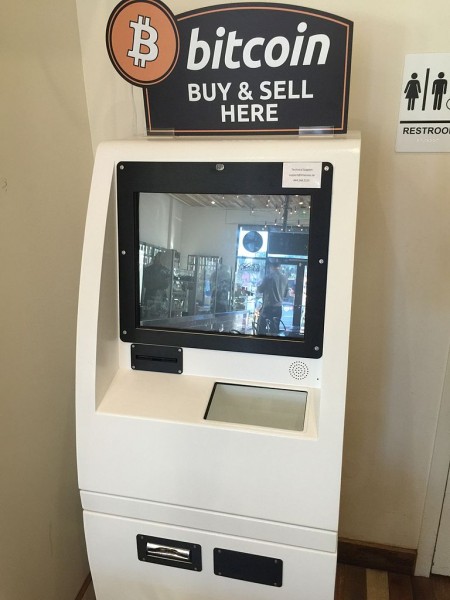 The problem with bubbles is that they will burst, but just when is virtually impossible to predict with any accuracy. If the price of bitcoins falls, what will happen next depends on how the fall is interpreted. It could be interpreted as a temporary fall, caused by some people cashing in to take advantage of the higher prices. At the same time, other people, believing that it is only a temporary fall, will rush to buy, snapping up bitcoins at the temporary low price. This ‘stabilising speculation’ will move the price back up again.
The problem with bubbles is that they will burst, but just when is virtually impossible to predict with any accuracy. If the price of bitcoins falls, what will happen next depends on how the fall is interpreted. It could be interpreted as a temporary fall, caused by some people cashing in to take advantage of the higher prices. At the same time, other people, believing that it is only a temporary fall, will rush to buy, snapping up bitcoins at the temporary low price. This ‘stabilising speculation’ will move the price back up again.
However, the fall in price may be seen as the bubble bursting, with even bigger falls ahead. In this case, people will rush to sell before it falls further, thereby pushing the price even lower. This destabilising speculation will amplify the fall in prices.
But even if the bubble does burst, people may believe that another bubble will then occur and, once they think the bottom has been reached, will thus start buying again and there will be a second speculative rise in the price.
The crash could be very short-lived. This happened with the second biggest cryptocurrency, Ethereum. On 21 June this year, the price at the beginning of the day was $360. It then began to fall during the say. Once its price reached $315, it then collapsed by 96% to $13 with massive selling, much of it automatic with computers programmed to sell when the price falls by more than a certain amount. But then, on the same day, it rebounded. Within minutes it had bounced back and was trading at $337 at the end of the day. It is now trading at around $450 – up from around $300 four weeks ago.
Whether the bubble in bitcoin has more to inflate, when it will burst, and when it will rebound and by how much, depends on people’s expectations. But what we are looking at here is people’s expectations of what other people are likely to do – in other words, of other people’s expectations, which in turn depend on their expectations of other people’s expectations. This situation is known as a Keynesian Beauty Contest (see the blog, A stock market beauty contest of the machines). Perhaps we need a crystal ball.
Information site
Articles
- Is Bitcoin a bubble? Here’s what two bubble experts told us
Trade Online, Timothy B. Lee (8/12/17)
- Bitcoin and tulipmania have a lot more in common than you might think
Business Insider, Seth Archer (8/12/17)
- Bitcoin ends dramatic week with 20% slump followed by recovery
The Guardian, Jill Treanor (8/12/17)
- Putting a price on Bitcoin
The Economist, Buttonwood’s notebook (8/12/17)
- Is Bitcoin a Bubble Waiting to Pop?
InvestorPlace, Matt McCall (8/12/17)
- Bitcoin bubble follows classic pattern of investment mania
Financial Times, John Authers (8/12/17)
- The Bitcoin bubble – how we know it will burst
The Conversation, Larisa Yarovaya and Brian Lucey (6/12/17)
- Bitcoin isn’t a currency – and unless it becomes one it could be worthless
The Conversation, Vili Lehdonvirta (6/12/17)
- How Bitcoin futures trading could burst the cryptocurrency’s bubble
The Conversation, Nafis Alam (13/12/17)
- Op-ed: Bitcoin Is Not a Bubble; It’s in an S-Curve and It’s Just Getting Started
Bitcoin Magazine, Brandon Green (8/12/17)
- Bitcoin vs history’s biggest bubbles: They never end well
CNN Money, Daniel Shane (8/12/17)
- The 10 Most Ridiculous Price Bubbles In History
Business Insider, Vincent Fernando and Anika Anand (11/10/10)
- After bitcoin’s wild week, traders brace for futures launch
Reuters, Saqib Iqbal Ahmed (10/12/17)
Cryptocurrencies current market prices
Questions
- To what extent does Bitcoin meet the functions of money?
- Why is bitcoin unsuitable for normal transactions?
- To what extent is bitcoin like gold as a means of holding wealth?
- How would you advise someone thinking of buying bitcoin today? Explain why.
- Does a rapid rise in the price of an asset always indicate a bubble? Explain
- To what extent is the current rise in the price of bitcoin similar to that of the tulip, Poseidon and Beanie Baby bubbles?
- If bitcoin is appreciating relative to the dollar and other currencies, does this mean that the price of goods and services valued in bitcoin are falling? Explain.
- Explain and comment on the following sentence from the first Conversation article: “Like any asset, Bitcoin has some fundamental value, even if only a hope value, or a value arising from scarcity.”
- How might the introduction of futures trading in bitcoin impact on its price and the volatility of price swings?
- Explain and assess the argument that the price trend of bitcoin is more likely to be an S curve rather than a roller coaster
 Your Americano, Latte or Cappuccino may soon be more expensive. This is because coffee bean prices are rising. A combination of continuing growth in demand and poor coffee harvests in various parts of the world have led to a rise in both Arabica and Robusta prices, with the International Coffee Organization’s Composite Indicator price (in US dollars) having risen by over 30% since mid-January this year (see chart below: click here for a PowerPoint)
Your Americano, Latte or Cappuccino may soon be more expensive. This is because coffee bean prices are rising. A combination of continuing growth in demand and poor coffee harvests in various parts of the world have led to a rise in both Arabica and Robusta prices, with the International Coffee Organization’s Composite Indicator price (in US dollars) having risen by over 30% since mid-January this year (see chart below: click here for a PowerPoint)
Supply has been affected by droughts in Brazil and Vietnam, two of the world’s biggest coffee producers, and by pests (the Coffee Berry Borer) in the Kilimanjaro region of Tanzania and in other East African countries. Global exports of coffee in July 2016 were 22% down on the same month in 2015.
The growing shortage and rising current (spot) prices is reflected in future prices. 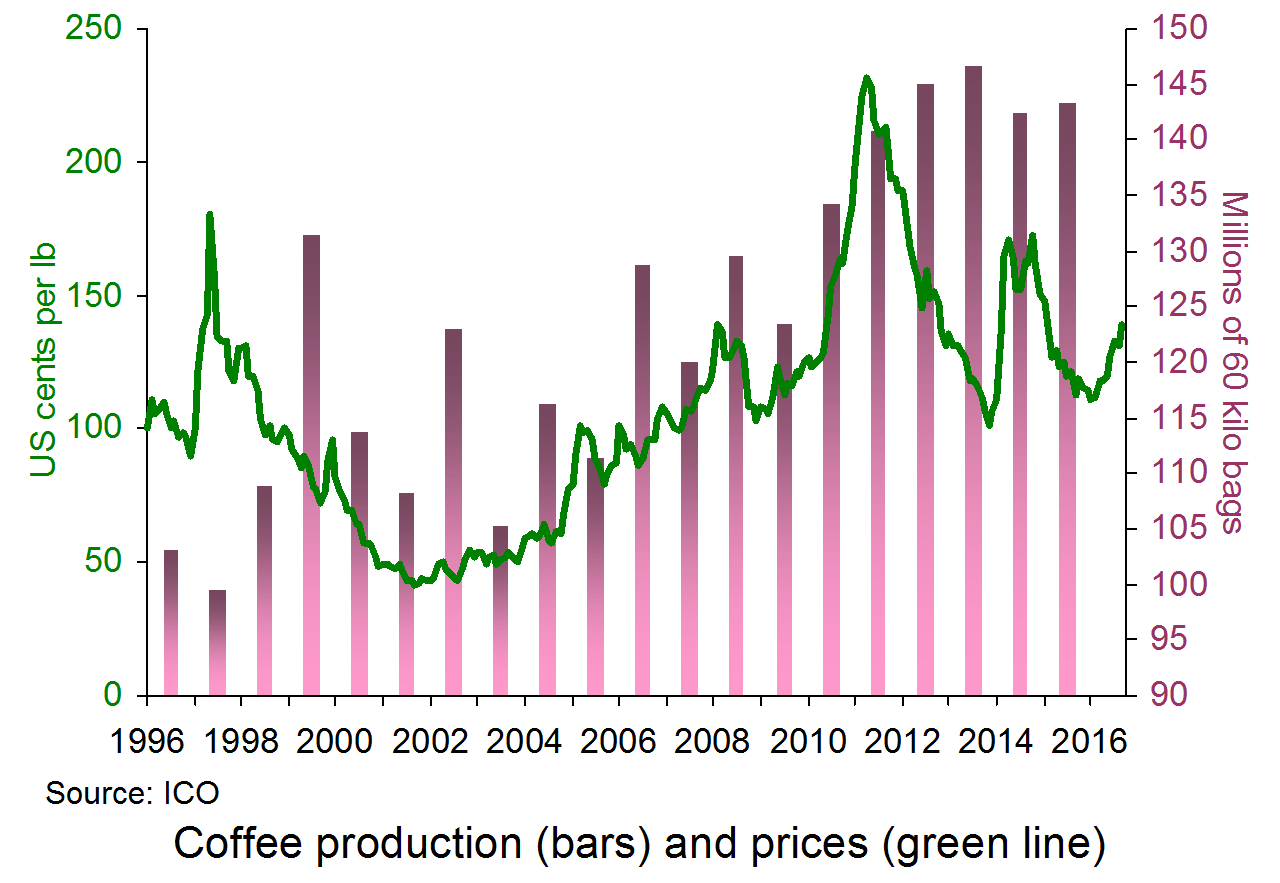 These are prices determined in the market now for trading at a specified future date (e.g. in three months’ time). Future prices depend on predictions of the balance of demand and supply in the future. According to the MarketWatch article below, “Analysts at Société Générale in a note predicted that prices could climb about 30% further by the end of next year”. The current (mid-September) spot price of robusta coffee beans is around $0.96 per lb. The December 2016 future price is around $1.48.
These are prices determined in the market now for trading at a specified future date (e.g. in three months’ time). Future prices depend on predictions of the balance of demand and supply in the future. According to the MarketWatch article below, “Analysts at Société Générale in a note predicted that prices could climb about 30% further by the end of next year”. The current (mid-September) spot price of robusta coffee beans is around $0.96 per lb. The December 2016 future price is around $1.48.
 So what effect will this have on the prices in Starbucks, Costa or Caffè Nero? And what effect will it have on ground or instant coffee in supermarkets? To quote the MarketWatch article again:
So what effect will this have on the prices in Starbucks, Costa or Caffè Nero? And what effect will it have on ground or instant coffee in supermarkets? To quote the MarketWatch article again:
A research report from the US Department of Agriculture found that, on average, a 10% increase in green-coffee-bean prices per pound would yield a 2% increase in both manufacturer prices and at the register in places like Starbucks Corp.
This is because the cost of coffee beans is just one element in the costs of coffee roasters and coffee shops. Also these companies use futures markets to smooth out the prices they pay. They hold stockpiles of coffee, which they build up when prices are low and draw on when prices are high. This helps to reduce fluctuations in retail prices.
So don’t worry too much about the price of your morning coffee – at least, not yet.
Articles
Why a surge in coffee-bean prices may not hit the Starbucks set—yet MarketWatch, Rachel Koning Beals (9/9/16)
Wired coffee prices may not slip far News Markets, David Cottle (9/9/16)
Late-harvest woes prompt Brazil coffee harvest downgrade Agrimoney (7/9/16)
Look Out, Latte Lovers: Brazil Drought Hurts Espresso Beans Bloomberg, Fabiana Batista and Marvin G. Perez (13/9/16)
Why Your Morning Coffee Is About to Become Even More Expensive Fortune (28/7/16)
Climate change brews a storm for East Africa coffee farmers Business Daily (East Africa), Paul Redfern (4/9/16)
Coffee Market Report ICO (August 2016)
Data
Commodity Prices Index Mundi
Historical Data on the Global Coffee Trade ICO
ICO’s Coffee Trade Statistics Infographic for July 2016 ICO blog (31/8/16)
Questions
- What determines coffee futures prices?
- How are the price fluctuations of coffee in coffee shops related to the price elasticities of demand and supply? What determines these elasticities?
- Why does a strengthening (an appreciation) of the currency of a coffee exporter affect (a) the price of coffee to producers in the country; (b) international coffee prices in dollars?
- Are poor coffee harvests on balance good or bad for coffee producers? How does this depend on the market price elasticity of demand? Does the answer vary from producer to producer?
- How does speculation affect coffee prices (both spot and future)? Is such speculation of benefit to (a) the coffee consumer; (b) the coffee grower?
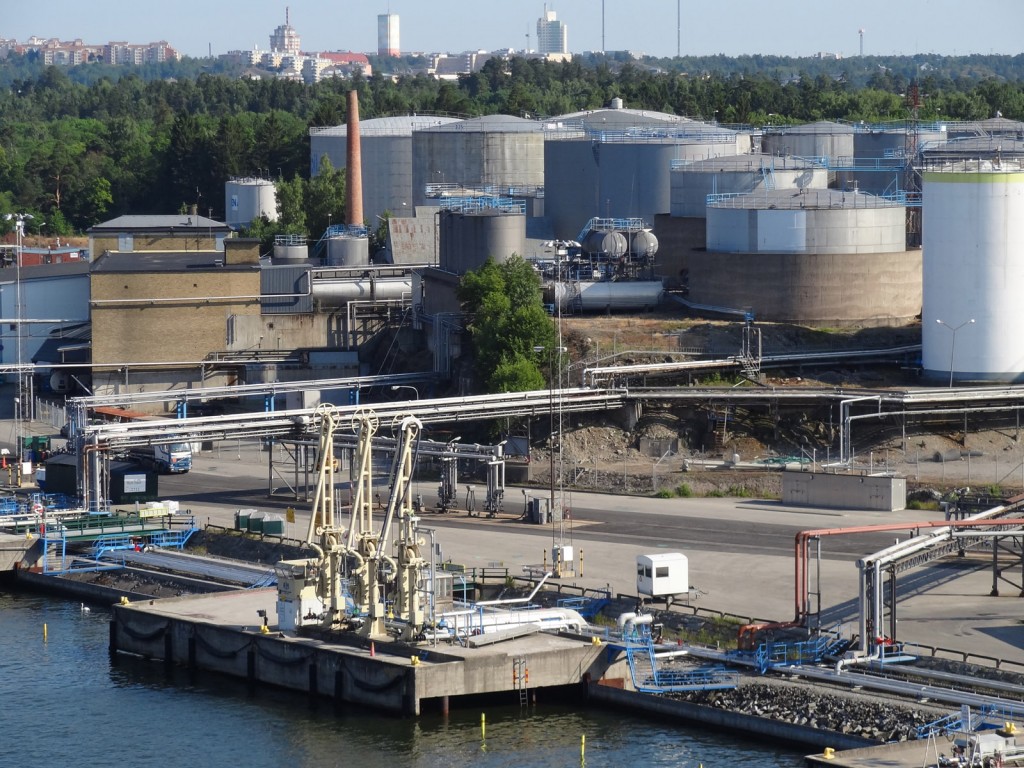 Over the past three months oil prices have been falling. From the beginning of September to the end of November Brent Crude has fallen by 30.8%: from $101.2 to a four-year low of $70.0 per barrel (see chart below: click here for a PowerPoint). The fall in price has been the result of changes in demand and supply.
Over the past three months oil prices have been falling. From the beginning of September to the end of November Brent Crude has fallen by 30.8%: from $101.2 to a four-year low of $70.0 per barrel (see chart below: click here for a PowerPoint). The fall in price has been the result of changes in demand and supply.
As the eurozone, Japan, South America and other parts of the world have struggled to recover, so the demand for oil has been depressed. But supply has continued to expand as the USA and Canada have increased shale oil production through fracking. 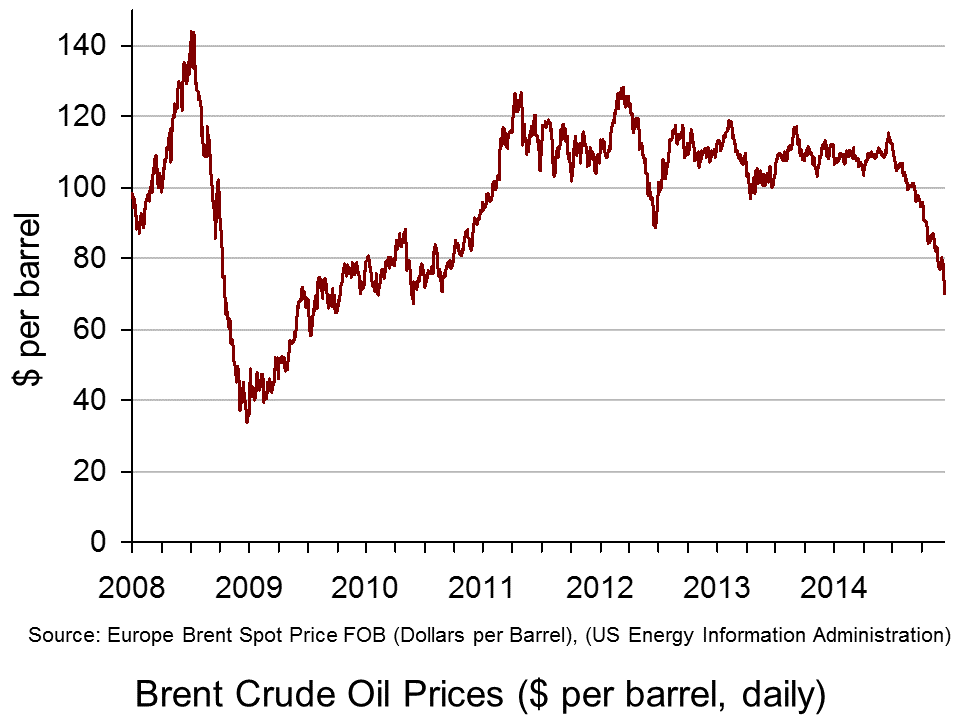 As far as OPEC is concerned, rather than cutting production, it decided at a meeting on 27 November to maintain the current target of 30 million barrels a day.
As far as OPEC is concerned, rather than cutting production, it decided at a meeting on 27 November to maintain the current target of 30 million barrels a day.
The videos and articles linked below look at these demand and supply factors and what is likely to happen to oil prices over the coming months.
They also look at the winners and losers. Although falling prices are likely in general to benefit oil importing countries and harm oil exporting ones, it is not as simple as that. The lower prices could help boost recovery and that could help to halt the oil price fall and be of benefit to the oil exporting countries. But if prices stay low for long enough, this could lower inflation and even cause deflation (in the sense of falling prices) in many countries. This, in turn, could dampen demand (see the blog post, Deflation danger). This is a particular problem in Japan and the eurozone.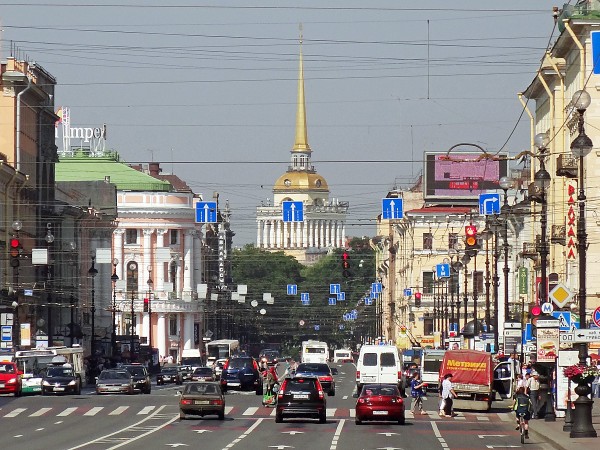 Major oil importing developing countries, such as China and India, however, should see a boost to growth from the lower oil prices.
Major oil importing developing countries, such as China and India, however, should see a boost to growth from the lower oil prices.
Some oil exporting countries will be harder hit than others. Russia, in particular, has been badly affected, especially as it is also suffering from the economic sanctions imposed by Western governments in response to the situation in Ukraine. The rouble has fallen by some 32% this year against the US dollar and nearly 23% in the past three months alone.
Then there are the environmental effects. Cheaper oil puts less pressure on companies and governments to invest in renewable sources of energy. And then there are the direct effects on the environment of fracking itself – something increasingly being debated in the UK as well as in the USA and Canada.
Videos
 Oil price at four-year low as Opec meets BBC News, Mark Lobel (27/11/14)
Oil price at four-year low as Opec meets BBC News, Mark Lobel (27/11/14)
 Opec losing control of oil prices due to US fracking BBC News, Nigel Cassidy (4/12/13)
Opec losing control of oil prices due to US fracking BBC News, Nigel Cassidy (4/12/13)
 How the price of oil is set – video explainer The Telegraph, Oliver Duggan (28/11/14)
How the price of oil is set – video explainer The Telegraph, Oliver Duggan (28/11/14)
 How Oil’s Price Plunge Impacts Wall Street Bloomberg TV, Richard Mallinson (28/11/14)
How Oil’s Price Plunge Impacts Wall Street Bloomberg TV, Richard Mallinson (28/11/14)
 Oil Prices Plummet: The Impact on Russia’s Economy Bloomberg TV, Martin Lindstrom (28/11/14)
Oil Prices Plummet: The Impact on Russia’s Economy Bloomberg TV, Martin Lindstrom (28/11/14)
Articles
Oil prices plunge after Opec meeting BBC News (28/11/14)
Crude oil prices extend losses Financial Times, Dave Shellock (28/11/14)
Oil price plunges after Opec split keeps output steady The Guardian, Terry Macalister and Graeme Wearden (27/11/14)
Falling oil prices: Who are the winners and losers? BBC News, Tim Bowler (17/10/14)Hooray for cheap oil BBC News, Robert Peston (1/12/14)
Russian Recession Risk at Record as Oil Price Saps Economy Bloomberg, Andre Tartar and Anna Andrianova (28/11/14)
Rouble falls as oil price hits five-year low BBC News (1/12/14)
Data
Brent Spot Price US Energy Information Administration (select daily, weekly, monthly or annual: can be downloaded to Excel)
Spot exchange rate of Russian rouble against the dollar Bank of England
Questions
- Use a diagram to illustrate the effects of changes in the demand and supply of oil on oil prices.
- How does the price elasticity of demand and supply of oil affect the magnitude of these price changes?
- Explain whether (a) the demand for and (b) the supply of oil are likely to be relatively elastic or relatively inelastic? How are these elasticities likely to change over time?
- Distinguish between the spot price and forward prices of oil? If the three-month forward price is below the spot price, what are the implications of this?
- Analyse who gains and who loses from the recent price falls.
- What are the effects of a falling rouble on the Russian economy?
- What are likely to be the effects of further falls in oil prices on the eurozone economy?
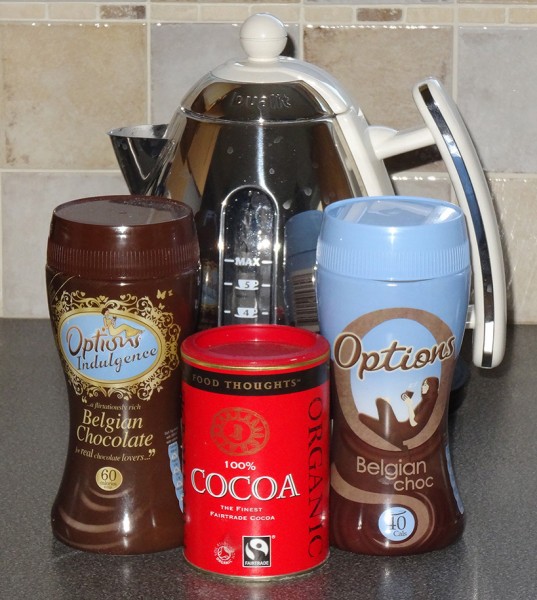 Your favourite chocolate bar or your drink of hot chocolate could soon be much dearer. Since March, the price of cocoa has risen by 34% and much of this increase remains to be passed on to the consumer. The price of cocoa butter is up 70% since the beginning of the year.
Your favourite chocolate bar or your drink of hot chocolate could soon be much dearer. Since March, the price of cocoa has risen by 34% and much of this increase remains to be passed on to the consumer. The price of cocoa butter is up 70% since the beginning of the year.
On the demand side, sales of luxury cocoa-rich chocolate and hot chocolate have been rising and chocolate manufacturers, with relatively low forward purchases of cocoa, are likely to have to buy more in spot markets. What is more, there is growing speculative demand as traders anticipate higher prices to come.
On the supply side, dry weather in West Africa, where 70% of cocoa beans are produced, has led to a fall in output. Estimates suggest that cocoa production in the 12 months to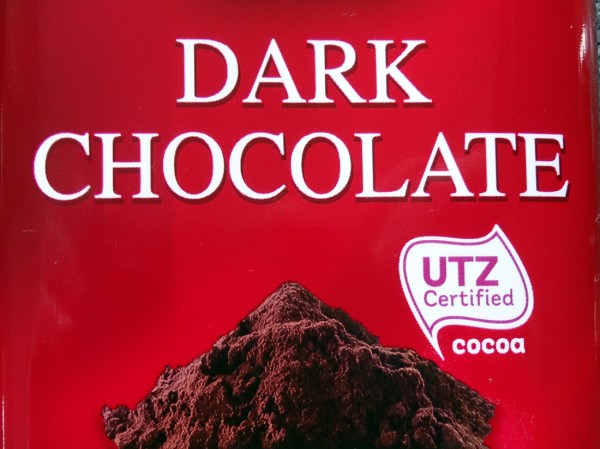 end-September 2013 will be 2.7% down on the previous 12 months. Supply is expected to be 60,000 tonnes less than demand, resulting in a fall in stocks from 1,833,000 to 1,773,000.
end-September 2013 will be 2.7% down on the previous 12 months. Supply is expected to be 60,000 tonnes less than demand, resulting in a fall in stocks from 1,833,000 to 1,773,000.
The following articles look at the ‘crisis’ for chocoholics and at the market conditions that lie behind it.
Articles
Craving for a chocolate fix? Prepare to pay more Reuters, Lewa Pardomuan and Marcy Nicholson (15/9/13)
Hot chocolate demand sends cocoa prices soaring Financial Times, Emiko Terazono (15/10/13)
Price of chocolate ‘to triple’ The Telegraph (8/10/13)
Paying more for chocolate? You will be CNN Money, Alanna Petroff (14/10/13)
Chocolate Prices Soar in Dark Turn The Wall Street Journal, Leslie Josephs and Neena Rai (22/9/13)
 Chocolate prices could increase as cocoa costs soar BBC News, Nigel Cassidy (21/10/13)
Chocolate prices could increase as cocoa costs soar BBC News, Nigel Cassidy (21/10/13)
… and on a lighter note: Rising Prices Signal A ‘Devastating’ Global Chocolate Crisis: Should Government Act To Save Us? Forbes, Doug Bandow (14/10/13)
Data
Cocoa beans: monthly price Index Mundi
ICCO daily prices of cocoa beans International Cocoa Organization (click on calendar to select month)
Production of cocoa beans International Cocoa Organization (click on Statistical Data links in right hand panel
Monthly review of the market International Cocoa Organization
Questions
- What happened to cocoa prices from January 2009 to March 2013? Explain this movement in prices.
- Why have cocoa prices risen so much since March 2013? Illustrate your analysis with a supply and demand diagram.
- If the demand for luxury chocolate fluctuates considerably with the state of the business cycle, what does this suggest about the income elasticity of demand for luxury chocolate?
- How would you establish whether or not cheap chocolate is an inferior good?
- If cocoa prices rise by 34%, what determines the percentage by which a bar of chocolate will rise?
- What determines the difference between cocoa futures and spot prices?
- How realistically could government intervention improve the lot of chocoholics?
 Coffee prices have been soaring in recent months. This applies to the prices of both coffee beans on international markets, coffee in supermarkets and coffee in coffee shops. In this blog we examine the causes and what is likely to happen over the coming months.
Coffee prices have been soaring in recent months. This applies to the prices of both coffee beans on international markets, coffee in supermarkets and coffee in coffee shops. In this blog we examine the causes and what is likely to happen over the coming months. Coffee prices are extremely volatile – more so than production, which does, nevertheless, fluctuate with the harvest. Figure 1 shows global coffee production and prices since 1996. The price is the International Coffee Organization’s composite indicator price (I-CIP) in US cents per pound (lb). It is a weighted average of four prices: Colombian milds (Arabica), Other milds (Arabica), Brazilian naturals (mainly Arabica) and Robusta. Production is measured in 60 kilo bags.
Coffee prices are extremely volatile – more so than production, which does, nevertheless, fluctuate with the harvest. Figure 1 shows global coffee production and prices since 1996. The price is the International Coffee Organization’s composite indicator price (I-CIP) in US cents per pound (lb). It is a weighted average of four prices: Colombian milds (Arabica), Other milds (Arabica), Brazilian naturals (mainly Arabica) and Robusta. Production is measured in 60 kilo bags.  In early October 2023, the ICO composite indicator price (I-CIP), was $1.46 per lb. By 28 August, it had reached $2.54 – a rise of 74%. Colombian milds (high-quality Arabica) had risen from $1.79 per lb to $2.78 – a rise of 55%. Robusta coffee is normally cheaper than Arabica. It is mainly used in instant coffee and for espressos. As the price of Arabica rose, so there was some substitution, with Robusta coffees being added to blends. But as this process took place, so the gap between the Arabica and Robusta prices narrowed. Robusta prices rose from $1.14 in early October 2023 to £2.36 in late August – a rise of 107%. These prices are illustrated in Figure 2 (click here for a PowerPoint).
In early October 2023, the ICO composite indicator price (I-CIP), was $1.46 per lb. By 28 August, it had reached $2.54 – a rise of 74%. Colombian milds (high-quality Arabica) had risen from $1.79 per lb to $2.78 – a rise of 55%. Robusta coffee is normally cheaper than Arabica. It is mainly used in instant coffee and for espressos. As the price of Arabica rose, so there was some substitution, with Robusta coffees being added to blends. But as this process took place, so the gap between the Arabica and Robusta prices narrowed. Robusta prices rose from $1.14 in early October 2023 to £2.36 in late August – a rise of 107%. These prices are illustrated in Figure 2 (click here for a PowerPoint). Supply-side factors. The first is poor harvests, which will affect future supply. Frosts in Brazil have affected Arabica production. Also, droughts – partly the result of climate change – have affected harvests in major Robusta-producing countries, such as Vietnam and Indonesia. With the extra demand from the substitution for Arabica, this has pushed up Robusta prices as shown in Figure 2. Another supply-side issue concerns the increasingly vulnerability of coffee crops to diseases, such as coffee rust, and pests. Both reduce yields and quality.
Supply-side factors. The first is poor harvests, which will affect future supply. Frosts in Brazil have affected Arabica production. Also, droughts – partly the result of climate change – have affected harvests in major Robusta-producing countries, such as Vietnam and Indonesia. With the extra demand from the substitution for Arabica, this has pushed up Robusta prices as shown in Figure 2. Another supply-side issue concerns the increasingly vulnerability of coffee crops to diseases, such as coffee rust, and pests. Both reduce yields and quality. Demand-side factors. On the demand side, the rise of the coffee culture and a switch in demand from tea to coffee has led to a steady growth in demand. Growth in the coffee culture has been particularly high in Asian markets as rapid urbanistion, a growing middle class and changing lifestyles drive greater coffee consumption and greater use of coffee shops. This has more than offset a slight decline in coffee shop sales in the USA. In the UK, the number of coffee shops has risen steadily. In 2023, there were 3000 cafés, coffee chains and other venues serving coffee, of which 9885 were branded coffee shop outlets, such as Costa, Caffè Nero and Starbucks. Sales in such coffee chains rose by 11.9% in 2023. Similar patterns can be observed in other countries, all helping to drive a rise in demand.
Demand-side factors. On the demand side, the rise of the coffee culture and a switch in demand from tea to coffee has led to a steady growth in demand. Growth in the coffee culture has been particularly high in Asian markets as rapid urbanistion, a growing middle class and changing lifestyles drive greater coffee consumption and greater use of coffee shops. This has more than offset a slight decline in coffee shop sales in the USA. In the UK, the number of coffee shops has risen steadily. In 2023, there were 3000 cafés, coffee chains and other venues serving coffee, of which 9885 were branded coffee shop outlets, such as Costa, Caffè Nero and Starbucks. Sales in such coffee chains rose by 11.9% in 2023. Similar patterns can be observed in other countries, all helping to drive a rise in demand. The rise in demand and prices over the years has led to an increase in supply as more coffee bushes are planted. As Figure 1 shows, world supply increased from 87 million in 1995/6 to 178 million 60 kilo bags in 2023/4 – a rise of 105%. The current high prices may stimulate farmers to plant more. But as it can take four years for coffee plants to reach maturity, it may take time for supply to respond. Later on, a glut might even develop! This would be a case of the famous cobweb model (see Case Study 3.13 on the Essentials of Economics 9th edition student website).
The rise in demand and prices over the years has led to an increase in supply as more coffee bushes are planted. As Figure 1 shows, world supply increased from 87 million in 1995/6 to 178 million 60 kilo bags in 2023/4 – a rise of 105%. The current high prices may stimulate farmers to plant more. But as it can take four years for coffee plants to reach maturity, it may take time for supply to respond. Later on, a glut might even develop! This would be a case of the famous cobweb model (see Case Study 3.13 on the Essentials of Economics 9th edition student website).










